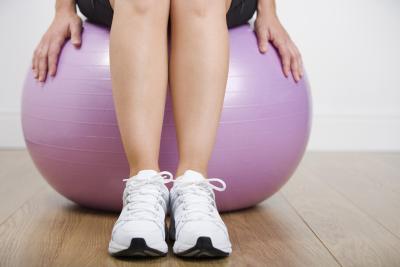Kids need muscle strengthening exercises, like calisthenics, at least three times a week, according to the Centers for Disease Control. A stability ball can keep your child engaged and interested, improve his posture and help him learn to balance. Stability balls work the whole body, but are especially good for the core muscles in the abdomen, back and pelvis.
Size
If your child is interested in using a stability ball, be sure to purchase one sized for her frame. Older kids may use a 55 cm ball if they are over five feet tall but less than five feet, seven inches. Younger children may need a 30 cm ball if they are under four feet, six inches, according to the American Council on Exercise. Have your child stand against a wall and slide down into a seated or chair position with the thighs parallel to the floor. Measure the distance between the floor and thighs and choose the ball that most closely matches this measurement.
Build Balance
Stability ball exercises build balance and may help kids to do better academically, particularly in reading, according to physical education teacher Meg Greiner. Encourage children to balance on the ball with both feet off of the ground. Kids can bounce, alternating foot positions or moving from side to side. More challenging balancing exercises include pushups with feet resting on the ball or curl ups, where the lower legs pull the ball in toward the abdomen.
Group Games
Use a stability ball as a large play ball for groups of children. Have children stand in a circle, pushing or kicking the ball between them. Bare feet add to the fun. This cooperative game works well for children of different ability levels or those with special needs. Kids can work on aiming skills, confidence and enjoy low-stress sensory stimulation with a simple ball game like this. Choose the largest ball possible for this activity.
Muscle Building
Calisthenic exercises, including crunches, push-ups and reverse crunches are both harder and a bit sillier done on a stability ball. Kids can lie on the floor and pass the ball from their hands to feet or roll the ball under the lower back and crunch up to work the abs. Try frog jumps for a fun way to work the lower body, recommends “Fitness” magazine. Stand behind the ball, legs spread and squat deeply. Grab the ball and jump straight up, as high as you are able.
Warning
While the CDC recommends muscle building exercises for children, if your child has been quite sedentary, you should consult his health care provider before beginning a new fitness regimen. Children who are overweight or out of shape may do better on a slightly larger, softer ball, at least until they become comfortable with the exercise, suggests the American Council on Exercise.





